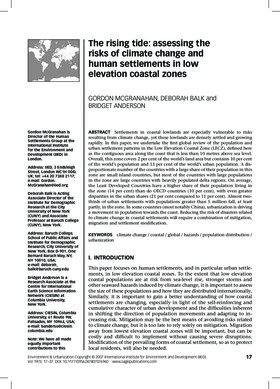The rising tide: assessing the risks of climate change and human settlements in low elevation coastal zones

Settlements in coastal lowlands are especially vulnerable to risks resulting from climate change, yet these lowlands are densely settled and growing rapidly. In this paper, we undertake the first global review of the population and urban settlement patterns in the Low Elevation Coastal Zone (LECZ), defined here as the contiguous area along the coast that is less than 10 metres above sea level. Overall, this zone covers 2 per cent of the world's land area but contains 10 per cent of the world's population and 13 per cent of the world's urban population. A disproportionate number of the countries with a large share of their population in this zone are small island countries, but most of the countries with large populations in the zone are large countries with heavily populated delta regions. On average, the Least Developed Countries have a higher share of their population living in the zone (14 per cent) than do OECD countries (10 per cent), with even greater disparities in the urban shares (21 per cent compared to 11 per cent). Almost two-thirds of urban settlements with populations greater than 5 million fall, at least partly, in the zone. In some countries (most notably China), urbanization is driving a movement in population towards the coast. Reducing the risk of disasters related to climate change in coastal settlements will require a combination of mitigation, migration and settlement modification.
Cite this publication
Available at https://www.iied.org/g02276